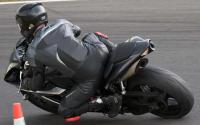Pico Systems boards
- jmelson
- Offline
- Moderator
-

- Posts: 820
- Thank you received: 157
Well, 25 us is not too bad. With the USC board, you turn off the base thread entirely, and only use the servo thread. The Intel D510MO is really small, about 7" square, with a Pico-PSU it runs off 12 V, which can also be used to run the USC. The D510MO with Pico-PSU, memory and a SSD can be had for around $150, maybe better if you search around. It has a funny parallel port that needs the very latest 2.4.6 version of EMC.
The base thread shows about 25us latency, it's not enough to be catastrophic but enough to mean that my speeds on 1/8 micro-step are limited. I have runt the test many times and that is the number that always comes back. The motors run decent at low step rates like 1/2 stepping but not so good at higher micro-step rates. The servo thread hits 300us but letting it run never sees it go beyond that. I think I just have to admit I have to go for a new PC. Its an Optiplex GX620 and there is no expansion ability. Do you know of a similar small footprint PC that is known to work? I don't want a tower PC as the cabinet I built was based on something small like this one.
A short piece of ribbon cable can be made up to go between the 26-pin header on the D510 and the USC board. I have tested this combination.
Jon
Please Log in or Create an account to join the conversation.
- jmelson
- Offline
- Moderator
-

- Posts: 820
- Thank you received: 157
That might require another cable to go between the connectors. Better to make your own short cable with a female DB-25 on one end and a female 26-pin header on the other. You have to snip off the 26th wire at the DB-25 end. The connectors I used are from Digi-Key, the CSR26G and the CFP25G. I have tested it with a one-foot plain ribbon cable.photomankc wrote:
how is the para-port connected on it? I see a pin header, do they make a standard 25pin connector that terminates in a pin header socket?
That connector is ideal for the 7i43, but as this is the Pico section I guess you will need back-panel header. They are pretty cheap.
cgi.ebay.com/Serial-Parallel-PCI-Slot-He...-Cable-/200557031594
For example
Jon
Please Log in or Create an account to join the conversation.
- photomankc
- Offline
- Senior Member
-

- Posts: 71
- Thank you received: 4
I rechecked last night and the servo thread always shows the 300,000ns jitter so that a servo period can't get much better than 1.3ms. If that will still work for the pico board then I may go that route. This PC was and by the looks of it by the time I build a new Atom based system since my case won't work it will be getting up there close to the board and I still would need to get a spindle control board and charge pump.anyway.
Please Log in or Create an account to join the conversation.
- Einar
- Offline
- Senior Member
-

- Posts: 56
- Thank you received: 1
I just downloaded the Ubuntu image and plan on installing it.
I have the USC board that I used on EMC years ago and I seem to remember there was some problem using it with EMC2. Is this correct? The EEPROM is marked: "09/19/02" if I'm correct. It is a bit hard to see.
Please Log in or Create an account to join the conversation.
- andypugh
-

- Offline
- Moderator
-

- Posts: 23377
- Thank you received: 4966
Jon is active on this forum, so should be able to give a definitive answer fairly soon.
Please Log in or Create an account to join the conversation.
- jmelson
- Offline
- Moderator
-

- Posts: 820
- Thank you received: 157
That unit must be quite old. However, it should still work with EMC2, with some limitations. The biggest is that it may not work with the latest 3.3 V parallel ports. There are some terminating resistors and such that can be added to make it work with those, but first I'd try it out and see if it works with your computer.Hello,
I just downloaded the Ubuntu image and plan on installing it.
I have the USC board that I used on EMC years ago and I seem to remember there was some problem using it with EMC2. Is this correct? The EEPROM is marked: "09/19/02" if I'm correct. It is a bit hard to see.
The EMC2 driver will recognize the USC firmware version and will know what features it can support.
You will need an IEEE-1284 cable, a standard DB-25 cable will not work.
Jon
Please Log in or Create an account to join the conversation.
- Einar
- Offline
- Senior Member
-

- Posts: 56
- Thank you received: 1
"Fairly soon" was an understatement. Thanks for your quick response Jon.
Yes it is old.
And I did have some issues when using it with EMC, but I think I still have the same cable that I used then.
Could the issue be using it with a lathe? Maybe that is what I asked for then and cannot remember now.
But this time it is for my mill, so I will try it. Then stage 1 now is to pop out and get some blank CD's.
Best Regards
Einar
Please Log in or Create an account to join the conversation.
- jmelson
- Offline
- Moderator
-

- Posts: 820
- Thank you received: 157
Well, axes are axes, but EMC2 now has much more sophisticated support for lathes, such as threading, rigid tapping, 2-axis offsets for lathe tools, etc.Wow!
"Fairly soon" was an understatement. Thanks for your quick response Jon.
Yes it is old.
And I did have some issues when using it with EMC, but I think I still have the same cable that I used then.
Could the issue be using it with a lathe? Maybe that is what I asked for then and cannot remember now.
But this time it is for my mill, so I will try it. Then stage 1 now is to pop out and get some blank CD's.
Best Regards
Einar
You may have some trouble getting the board to work with modern computers. I could send a firmware update, and also advise on how to install terminating resistors, or do it for you if you wanted to send it.
It may work fine with the on-motherboard parallel port, but is not likely to work with newer PCI card parallel ports, without the updates.
Jon
Please Log in or Create an account to join the conversation.
- Bob La Londe
- Offline
- New Member
-

- Posts: 14
- Thank you received: 0
Please Log in or Create an account to join the conversation.
- Einar
- Offline
- Senior Member
-

- Posts: 56
- Thank you received: 1
In a couple of months I will probably order another board and then also an EPROM upgrade. The next board will be for the lathe. I can install resistors myself if I get instructions. Soldering small surface mount components is really no problem when you have the rigt flux and a suitable tip.
Einar
Please Log in or Create an account to join the conversation.
